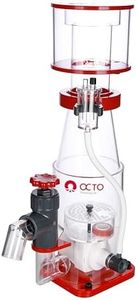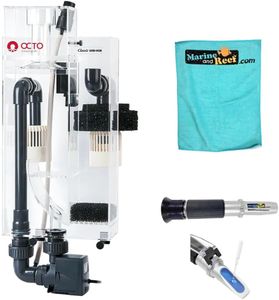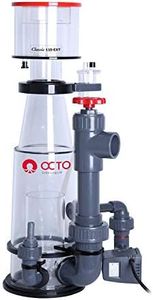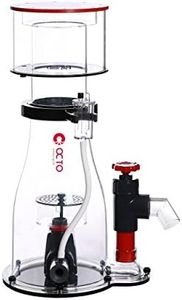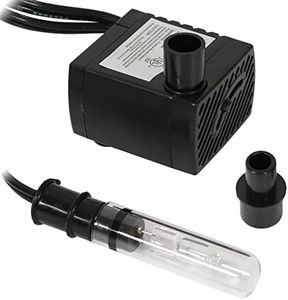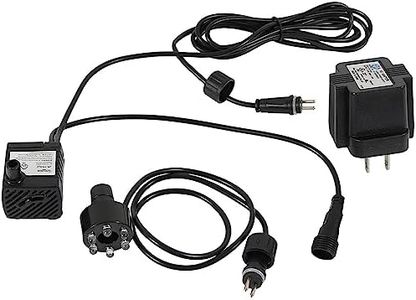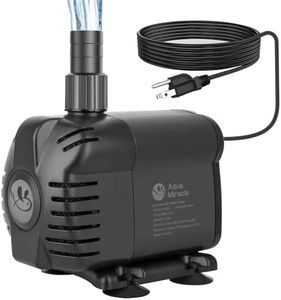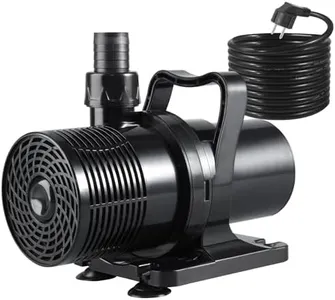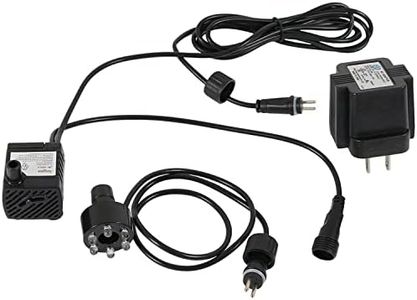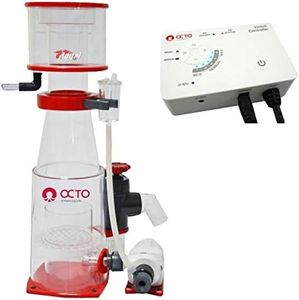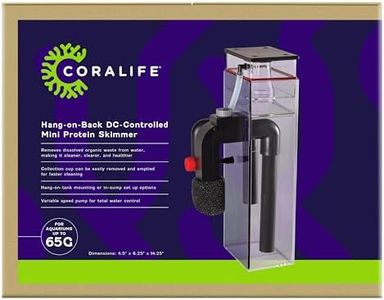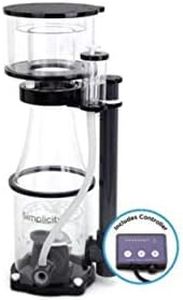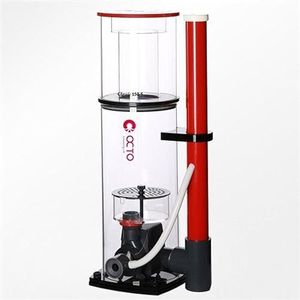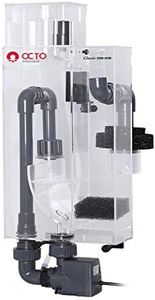10 Best Protein Skimmers 2025 in the United States
Our technology thoroughly searches through the online shopping world, reviewing hundreds of sites. We then process and analyze this information, updating in real-time to bring you the latest top-rated products. This way, you always get the best and most current options available.

Our Top Picks
Winner
MagTool Aquarium in-Sump DC Protein Skimmer, with Controllable DC Pinwheel Pump for Up to 50-100Gal Reef Tank (N100 Plus)
Most important from
67 reviews
The MagTool Aquarium in-Sump DC Protein Skimmer is designed for reef tanks ranging from 50 to 100 gallons. It offers powerful filtration in a compact size, making it ideal for space-limited installations. With a footprint of just 5.0x4.3 inches, it efficiently handles both heavy and light bio-loads. The skimmer features a controllable 265 GPH DC sine wave pump equipped with special needle wheel impellers, which generate a large volume of fine bubbles for effective skimming.
The advanced design elements, such as the hybrid-cone structure and a built-in air intake silencer, ensure near-silent operation and improved skimmer performance by reducing turbulence and creating a stable laminar flow. Additionally, the exclusive cell-cast diffuser further enhances the mixing of air and water, boosting efficiency. The skimmer's build quality is solid, using both plastic and metal materials, which adds to its durability. It consumes only 7 watts of power and operates automatically, adding convenience for the user.
Maintenance is straightforward, though the compact size may make internal access a bit tricky for those with larger hands. In terms of drawbacks, users need to consider the initial setup and tuning, which can be challenging for beginners. Despite its effectiveness and quiet operation, the skimmer may not be suitable for tanks larger than 100 gallons or those with extremely heavy bio-loads. It is an excellent choice for hobbyists looking for a reliable and efficient protein skimmer for mid-sized reef tanks.
Most important from
67 reviews
Reef Octopus OCTO Regal 150 SSS Space Saver Protein Skimmer
Most important from
11 reviews
The Reef Octopus OCTO Regal 150 SSS Space Saver Protein Skimmer is designed for aquariums of varying sizes, making it versatile for a range of tank setups. It is effective for tanks up to 210 gallons with light filtration needs, 160 gallons with medium filtration demands, and 100 gallons for high filtration requirements. This makes it suitable for both moderate and heavily stocked aquariums. Its small footprint (9” x 7.5”) and height (23.6”) ensure it doesn't take up much space, which is beneficial for users with limited sump space.
The skimmer is equipped with a controllable DC 2500S Pinwheel Pump, offering five energy-efficient power settings, allowing for customizable performance and potentially lower electricity costs. The build quality leverages modern materials and is designed to last, although it is primarily plastic, which might be a consideration for some users seeking more robust materials. Maintenance is another advantage, with a recommended sump water depth of 7” to 8.5” making it relatively easy to access and clean. However, it is essential to note that the product is not dishwasher safe, so manual cleaning is required.
In terms of noise, the controllable DC pump is generally quieter compared to traditional AC pumps, contributing to a more peaceful aquarium environment. The skimmer includes adapters for different plumbing setups, adding to its versatility. While customer reviews are highly positive, reflecting satisfaction with performance and build, the relatively high weight (12.47 pounds) might be a minor drawback for some users during installation or maintenance. In summary, the Reef Octopus OCTO Regal 150 SSS is a reliable and efficient protein skimmer that suits a variety of aquarium sizes, with ease of maintenance and noise levels being significant strengths. Potential users should consider the material and weight aspects based on their specific needs and preferences.
Most important from
11 reviews
Reef Octopus OCTO Classic 1000 HOB Protein Skimmer Bundle (3 items)
Most important from
1 reviews
The Reef Octopus OCTO Classic 1000 HOB Protein Skimmer Bundle is designed for various aquarium sizes, supporting up to 130 gallons for light bio loads, 50 gallons for medium bio loads, and 60 gallons for heavy bio loads. This makes it versatile for different needs. The 'hang-on-back' (HOB) design is user-friendly, with the pump mounted externally to save space in the tank and facilitate easier installation and operation.
The skimmer boasts efficient low heat performance, which is beneficial for maintaining a stable tank environment. Constructed with solid acrylic, the build quality is robust and durable. The included Aquatrance 1000s pinwheel pump offers adequate air and water flow rates, contributing to effective filtration. The pump's air draw is 420 liters per hour, and the water draw is 350 liters per hour, which supports the skimmer's performance. Additionally, the skimmer includes features like a surface skimmer and air silencer, reducing noise levels for a quieter operation.
Maintenance is straightforward, aided by the external pump, making it easier to access and clean compared to internal pumps. The bundle also includes a MarineAndReef reefractometer, which is specifically designed for marine and aquarium saltwater, and a durable, lint-free microfiber towel for maintenance tasks. A potential drawback could be the product's weight (12 pounds), which might be somewhat bulky for some users. Additionally, it is not dishwasher safe, so cleaning requires manual effort. The noise level is low, but some users may still find it noticeable.
Most important from
1 reviews
Buying Guide for the Best Protein Skimmers
Choosing the right protein skimmer for your aquarium is crucial for maintaining a healthy and clean environment for your aquatic life. Protein skimmers help remove organic waste before it breaks down into harmful substances, ensuring better water quality. When selecting a protein skimmer, consider the size of your tank, the type of skimmer, and the specific needs of your aquarium inhabitants. Here are some key specifications to help you make an informed decision.FAQ
Most Popular Categories Right Now

